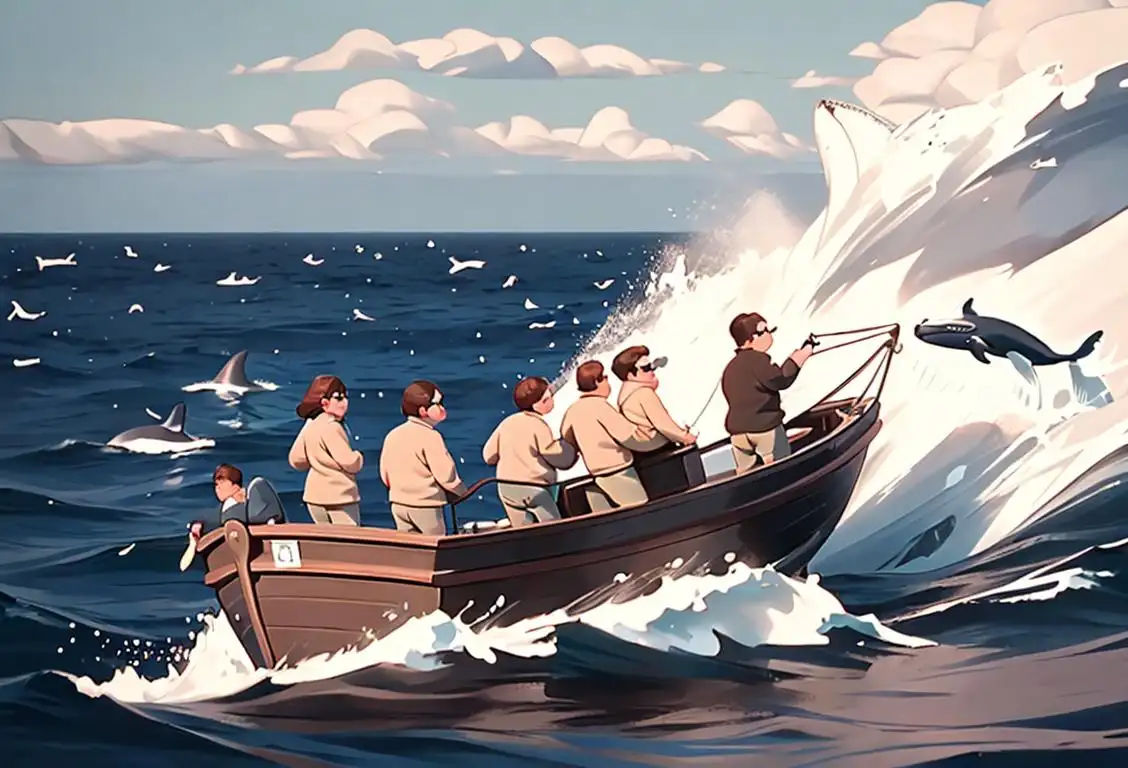National Whale Watch Day

Welcome to National Whale Watch Day, where we celebrate these magnificent creatures of the sea! It's time to grab your binoculars, set sail, and get ready for an adventure like no other. So, buckle up and dive into the fascinating world of whale watching with WhatNationalDayIsIt.com!
When is Whale Watch Day?
It's national whale watch day on the 23rd August.
The History of National Whale Watch Day
Did you know that National Whale Watch Day was first established on August 23, 2015? It all started with a surge of online mentions surrounding these gentle giants of the ocean. People were buzzing with excitement, sharing their experiences, and encouraging others to embark on remarkable whale-watching adventures.
Since then, this day has become a yearly celebration, raising awareness about the importance of marine conservation and fostering a deep appreciation for these incredible marine mammals.
Whale Watching: A Spectacular Experience
Whale watching is not just a hobby; it's an awe-inspiring experience that brings you up close and personal with some of the ocean's most majestic creatures. Imagine being on a boat, feeling the cool breeze on your face, and witnessing the breathtaking sight of whales sprouting water from their blowholes.
Whether you're watching from the shore or embarked on a thrilling whale-watching tour, the anticipation and excitement of spotting these massive marine creatures are truly unmatched. It's a thrilling adventure filled with anticipation, suspense, and unfiltered joy.
Preserving Our Oceans and Protecting Whales
National Whale Watch Day serves as a reminder of the importance of preserving our oceans and protecting these incredible creatures. Whales play a vital role in maintaining the delicate balance of marine ecosystems, and their preservation is essential for the overall health of our planet.
By promoting awareness and supporting initiatives focused on marine conservation, we can contribute to the well-being of whales and other marine life. So, let's take this day as an opportunity to educate ourselves and others on ways we can help save the whales!
History behind the term 'Whale Watch'
1800
The Birth of Commercial Whaling
In the early 1800s, commercial whaling was booming across the globe. Whales were hunted for their blubber, which could be rendered into oil for various purposes. As the demand for whale products grew, so did the number of ships that set out to hunt these magnificent creatures. This marked the beginning of an era when sailors and hunters recognized the value of whales not just for their resources, but also for their majestic presence in the oceans.
1952
The Rise of Whale Watching
In 1952, a small group of conservationists and nature enthusiasts led by Paul Spong and Michael Bigg started a movement that would forever change the way people interacted with whales. They decided to embark on a journey to observe and study these incredible creatures in their natural habitat, rather than hunting them down. This radical yet noble idea gave birth to what is now known as 'whale watching.' It was a way for people to appreciate whales without causing harm and to promote a deeper understanding of their behavior, ecology, and conservation.
1971
The Birth of the Modern Whale Watching Industry
In 1971, the first whale-watching tour was officially established in San Juan Islands, Washington. This marked the beginning of the modern whale watching industry. The tour allowed passengers to observe and marvel at the beauty of orcas (killer whales) in their natural habitat. The success of this venture sparked a global interest in whale watching and led to the development of commercial whale-watching operations in various coastal regions worldwide. It was a major turning point that shifted the focus from hunting whales to protecting and appreciating them.
1982
International Whaling Commission and Tourism
In 1982, the International Whaling Commission (IWC) enacted a moratorium on commercial whaling, banning the hunting of whales for profit. This decision further fueled the growth of the whale watching industry as former whaling communities sought alternative ways to sustain their livelihoods. Many coastal towns and cities began promoting whale watching as a form of sustainable tourism, attracting visitors from around the world. This transition not only helped protect whales but also provided economic opportunities for local communities and contributed to the conservation effort.
Present
Whale Watching as a Global Phenomenon
Today, whale watching has become a massive global phenomenon. It is a beloved activity that offers a unique and awe-inspiring experience to anyone fortunate enough to witness these magnificent creatures in their natural habitat. Tourists flock to coastal regions worldwide to catch a glimpse of various whale species, including humpback whales, blue whales, and even rare orcas. The popularity of whale watching has not only raised awareness about the need for whale conservation but has also become a significant source of revenue for coastal communities. It serves as a testament to the power of responsible tourism and humanity's ability to appreciate and protect the natural world.
Did you know?
Did you know that some whale species can communicate with each other using complex songs that can travel for miles through the ocean? It's like having your own underwater concert!Tagged
awarenessFirst identified
19th August 2015Most mentioned on
23rd August 2015Total mentions
9Other days
Nurses Day
Former Prisoner Of War Recognition Day
Press Day
Handloom Day
Heroes Day
Memorial Day
Dance Day
Bestfriends Day
Liberation Day
Love Your Pet Day









